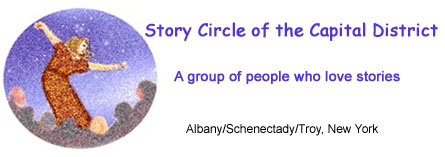|
Facilitator Guidelines
STORIES FIRST or PLEASURE BEFORE BUSINESS
What Does a Story Circle Facilitator Do?
Our Goal: the most stories and the most fun with the most courtesy and the least wasted time
The Facilitator:
- Arrives at 6:50 in Colonie and 6:00 in Albany
- Displays informative stuff, i.e. sample Talespinner, Goal Statement, brochures, flyers, publications about storytelling events, paper and pencil to write upcoming events for the Talespinner.
- Has paper and pen ready for attendance and story sign-up sheets. Gives to each new arrival and makes sure it gets to everyone.
Sample Heading for Attendance Sheet
| Name
| Address
(for first timers who will receive a sample Talespinner if requested here)
|
Email
|
Sample Heading for Story Sign-up Sheet
| Name | Story Title | Time | Story Source
| | 1.
| | 2.
| | 3.
| | 4.
| | etc.
|
- Sees that 12-15 chairs are in a circle
- Greets each new arrival, welcoming newcomers
- Begins at 7:00 in Colonie and 6:15 at Guilderland
Format:
- Introduces self as facilitator
- Invites each to give name and town and talk, in two or three sentences, about a topic selected by the Facilitator
- Ask for any additions to the story sign-up sheet. We try to be sure that everyone who came prepared to tell and wants to get a chance. This is the time to find tellers who’ve missed the sign-up sheet. If we run out of time, this is the order to use
- Introduces/explains the Process for Critical Response
- Asks who would like to be first, next, etc. Maintains pace
- Allows time for responses to each story as per Process sheet
- Stops about 8:30 to allow for quick information exchanges or in September, January or May, THE BUSINESS MEETING
- Makes sure each teller has written down name, story and source for the newsletter
- End the meeting at 8:55 and invite everyone to exit the library by 9:00 sharp. We can linger outside to talk more
- Gives the attendance sheet and the story sign-up sheet to the Newsletter Editor,
Claire Nolan
TIPS
The Facilitator ensures that the group follows basic understandings we tellers and listeners have come to through our years of trial and error:
- No one reads a story. Sometimes a guest misunderstands and thinks we are a writer’s group. Our purpose is to TELL stories.
Critiques need to be helpful, encouraging, giving positive support.
- For stories longer than 20 minutes, a teller calls the facilitator ahead and “books” time.
- Too many stories for the time? The Facilitator waits to tell his/her own story ‘til last or
waits ’til next month. About 8:20, a consensus can be reached on who from the sign- up sheet will tell the last one or two stories.
- Too few stories for the time? The facilitator may tell more than one story if she/he wants to, or may know a storytelling game, or invite ideas from the group. No one
should feel responsible for telling all the stories on a night when there are few tellers.
- Tellers need protection. To provide the best possible setting we avoid interruptions or writing during the telling. Early departures are between stories.
- Fall in love with a story heard here? If you long to tell it too, it’s good to talk to the teller first to see how he/she feels about it.
- Latecomers enter quietly, hold still, and are seated in the circle between stories. There is no time to introduce the circle all over again; you’re on your own.
Questions often asked by newcomers:
-
How do you learn to tell stories?
- How did Story Circle begin? What are its goals?
- A quick referral to to the Talespinner which lists workshops or to the Goal Statement
(at bottom of Critical Response sheet) and/or your number for later. This keeps from taking time away from storytelling. Be fierce.
|

